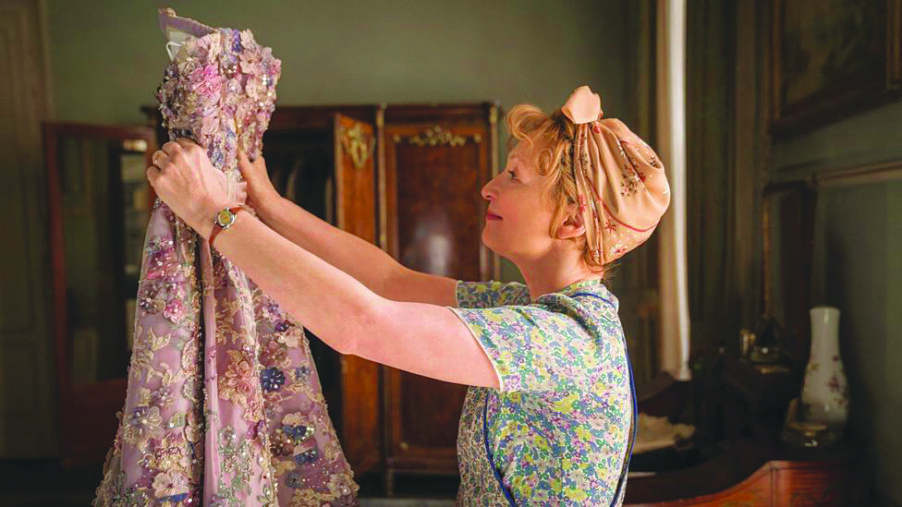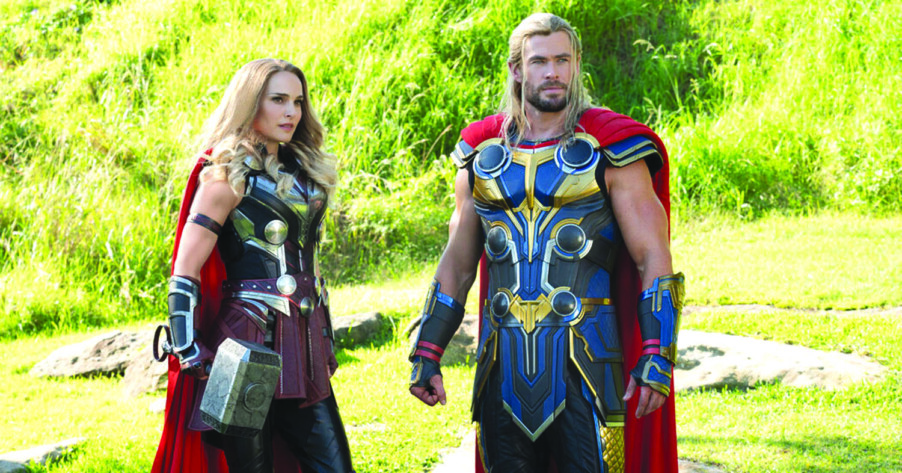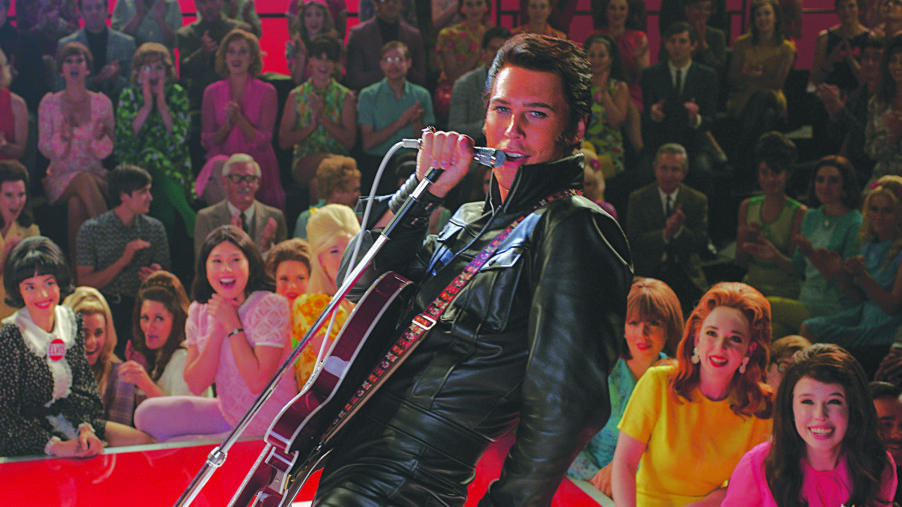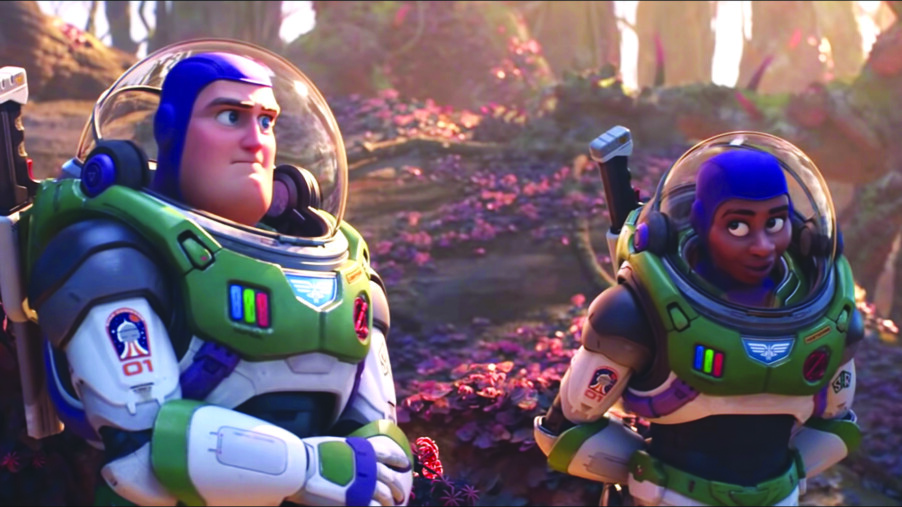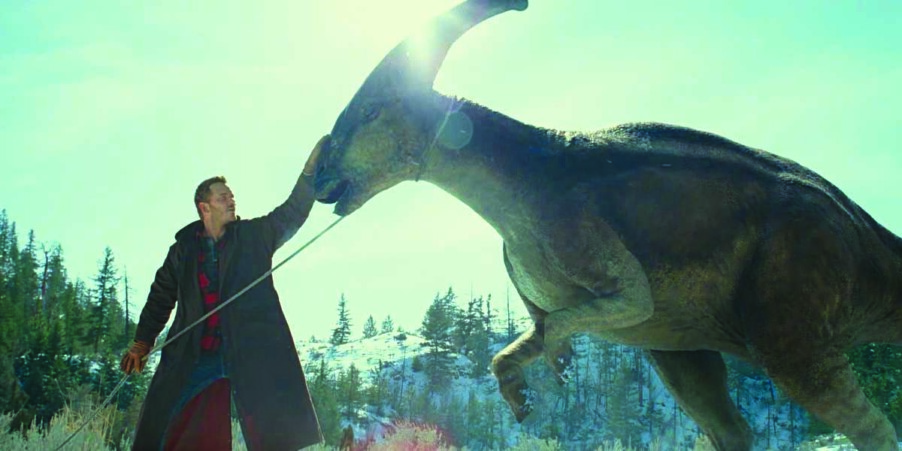Mrs. Harris Goes to Paris (PG)
A woman seeks to own a Dior dress in Mrs. Harris Goes to Paris, an absolute charmer of a midlife fairy tale.
London housecleaner Ada Harris (Lesley Manville) still talks about her husband Eddie, who didn’t return from the war but was only ever listed as “missing in action.” In 1957, she gets official word that the crash site of his plane was found and, with the return of his wedding ring, Ada is officially considered a widow by the British government. This turns out to be important for two reasons. The first is that some part of her had clearly hoped that her husband was still out there somewhere. The second is that she is owed 13 years of back widow’s benefits. Add that to some other small windfalls and she suddenly has the money to chase what has recently become her dream: to buy a Christian Dior dress.
After seeing a, as she calls it, “500 pound frock” at the home of a woman she cleans for, Ada, who appreciates not just the artistry of the dress but the escape and fantasy it represents, has decided she’s going to get herself one, even if she’s only wearing it to a local dance at the legion hall.
She flies to Paris, planning to only stay a day, but, after lucking into viewing the latest Dior collection, she learns that to have the dress of her dreams, she must stay a week or so to have it fitted. Luckily, she has charmed the Dior accountant, Andre Fauvel (Lucas Bravo), who invites her to crash at his Paris apartment and has made a friend in the Marquis de Chassagne (Lambert Wilson), who helps her see the possibility for romance again. Ada wins over Natasha (Alba Baptista), a Dior model with more academic aspirations, along with pretty much everyone she meets except Claudine Colbert (Isabelle Huppert), Dior’s number two and a stickler for the exclusivity that is the Dior brand.
This baby-bird-feather gentle movie also features Ellen Thomas and Jason Isaacs playing Ada’s understanding friends back home. Everybody here turns in a solid performance, suffused with warmth and kindness, even, ultimately, most of the jerkier characters. Leslie Manville very nearly twinkles at points but she carries it off without seeming dopey or naive. She gives Ada more personality, more inner life than what strictly appears on the surface.
Is it the most complex tale you’ll see all year? Probably not, but I dare you (particularly if you are a woman of a certain age; what age exactly I’m not sure except that I am definitely of that age) not to be won over by the ideas — that life can still change and surprise you (in the good way), beauty (and more important, feeling beautiful) is not the sole right of youth, hard work by people who spend a lot of time caring for others and not getting the glory will be rewarded. And there are pretty dresses! What’s not to like? B+
Rated PG for suggestive material, language and smoking, according to the MPA on filmratings.com. Directed by Anthony Fabian with a screenplay by Anthony Fabian & Carroll Cartwright & Keith Thompson & Olivia Hetreed (based on a 1958 novel by Paul Gallico, one of four Mrs. Harris novels), Mrs. Harris Goes to Paris is an hour and 55 minutes long and is distributed in theaters by Focus Features.
Where the Crawdads Sing (PG-13)
A solitary young woman in rural coastal North Carolina finds herself accused of murdering a former boyfriend in Where the Crawdads Sing, a slow and occasionally dopey drama.
In 1969, Kya Clark (Daisy Edgar-Jones) is known in her small North Carolina town of, I forget, Bumpkin Cove or something, as “marsh girl” because she has lived most of her life largely alone in a house out in the marsh. After her mother leaves Kya’s abusive father when she is a child (Jojo Regina) and one by one her other four siblings run off and then her father himself (Garret Dillahunt) fades away, Kya is left to care for herself. She earns a meager living by picking mussels and selling them to the kind couple, Jumpin’ (Sterling Macer Jr.) and Mabel (Michael Hyatt), who run a small store. Mabel helps Kya get shoes and learn basic math and just generally keeps an eye on this child that she knows is basically alone.
When Kya is a teenager, she reconnects with childhood friend Tate (Taylor John Smith), who shares her love of the natural world of their coastal-marsh-swamp environment and shows his affection for her by bringing her feathers and teaching her to read. But he has big college plans, so he leaves Kya, never returning or even writing her a letter. Since people vanishing without a trace is kind of a trigger for her, Kya basically decides to heck with Tate. Then, years later, she meets Chase (Harris Dickinson), a local jerkface whom she is worn down into dating largely because most people in town are openly terrible.
This story is told in flashback, starting with Kya’s childhood in the early 1950s and moving through the 1960s, as 1969 Kya sits in jail accused of Chase’s murder. Everyone sort of assumes that marsh girl, who is treated like something between Bigfoot and a witch, is of course guilty of killing this from-a-good-family man (never mind that everybody seems aware of his womanizing and general awfulness). Tom Milton (David Strathairn), a good-hearted retired lawyer, decides she isn’t getting a fair shake and takes her case.
This movie serves as an excellent tourism commercial for coastal North Carolina and also serves up some shabby-chic vibes in Kya’s marsh-nestled home, particularly once she’s decorating things how she likes them. And Edgar-Jones is, I guess, fine. Watching her — and because there is so much time when this molasses drip of a movie is just repeatedly underlining stuff we already know about how awful the townsfolk are or what an unsympathetic murder victim Chase is — I found myself thinking Edgar-Jones (who is British) has a Jane Eyre like quality that might work in some BBC adaptation. So hey, Edgar-Jones’ agent, take a few short clips from this movie and show it to whoever is making the inevitable Jane Eyre limited series. Short clips, because whenever Edgar-Jones and one of her two goober-y boyfriends spend too much of some scene just sort of gazing at each other the movie tips over from earnest to doofy. C+
Rated PG-13 for sexual content and some violence including sexual assault, according to the MPA on filmratings.com. Directed by Olivia Newman with a screenplay by Lucy Alibar (from the novel by Delia Owens), Where the Crawdads Sing is two hours and five minutes long and distributed in theaters by Sony Pictures Entertainment.
Paws of Fury: The Legend of Hank (PG)
In a land of cats, a dog seeks to become a mighty samurai in Paws of Fury: The Legend of Hank, an animated movie loosely based on Blazing Saddles, according to the internet, and featuring Mel Brooks with a small voice part.
Hank (voice of Michael Cera) the dog is about to be executed, largely for the crime of sneaking to the land of cats, when cat Ika Chu (voice of Ricky Gervais), a kind of middle-management government type, gets the idea to essentially give the dog what he wants and make him a samurai. Specifically, make him a samurai protecting Kakamucho, a town that Ika Chu wants wiped off the map to improve the view from the palace he built to impress the cat Shogun (voice of Brooks). The Shogun is slated to pick a successor soon and Ika Chu is certain he’ll get the job if the Shogun is wowed by the palace. He assumes that the townscats will be horrified that a dog has been sent to protect them and they’ll kill Hank, which will allow Ika Chu to arrest them all.
But Hank has some loveable goofus qualities and is able to find a reluctant mentor in the form of retired cat samurai Jimbo (voice of Samuel L. Jackson). With the help of Jimbo, Hank gains the begrudging respect of the Kakamucho residents. That is until Ika Chu decides to use that budding confidence to turn Hank into a little bit of an ego monster.
The movie also features the voices of George Takei, Djimon Hounsou, Michelle Yeoh and Aasif Mandvi. And, yes, in the spirit of the source material, we get some beans and toots.
As much as my kids enjoy fart humor, some of the killing- and violence-focused portions of the movie felt not quite sanded down enough for a younger audience. We get some fourth-wall-breaking meta humor (Hank realizing that he’s in the training montage part of the movie) but that also feels like a mix-in not thoroughly incorporated into the Dairy Queen Blizzard of this movie, which feels like has chunks of ideas throughout but never quite adds up to more than “watered down Kung Fu Panda.”
Ultimately Paws of Fury: The Legend of Hank feels like it needs more and less — more rewrites and more silliness, less discount Dreamworks aimed-at-the-adults jokes and less Ricky Gervais (for all that he’s a good villain here, he also feels like he takes over fairly regularly). I can see the potential but the movie as it is just feels underwhelming. C
Rated PG for action, violence, rude and suggestive humor and some language, according to the MPA on filmratings.com. Directed by Chris Bailey, Mark Koetsier and Rob Minkoff with a screenplay by Ed Stone & Nate Hopper (based on Blazing Saddles by Mel Brooks & Normal Steinberg & Andrew Berman & Richard Pryor & Alan Unger), Paws of Fury: The Legend of Hank is an hour and 38 minutes long and distributed in theaters by Paramount Pictures.
Featured photo: Mrs. Harris Goes to Paris.





